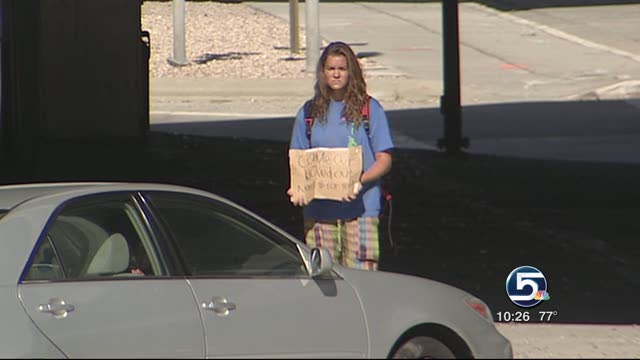Estimated read time: 4-5 minutes
This archived news story is available only for your personal, non-commercial use. Information in the story may be outdated or superseded by additional information. Reading or replaying the story in its archived form does not constitute a republication of the story.
MIDVALE — Sometimes the best way to understand another person's plight is to "walk a mile in their shoes." In that vein, a group of local teenagers took it upon themselves to find out what it would be like to be homeless.
The eight teens were all members of the St. James Episcopal Church in Midvale who spent several hours Saturday morning staked out at freeway off ramps, on street corners and outside of convenience stores with signs depicting their simulated circumstances as homeless or outcast youth asking for help.
The point of the "Youth for Youth" service project was to raise awareness about the growing issue of homelessness among the teenage and young adult population.
I was getting down on myself, and I was only out there for an hour. You get so many dirty looks and get called a bum.
–Andrew Hagedorn
"We're standing on freeway exits, entrances and nosiness fronts and we're asking for money," said Andrew Hagedorn, 18. "We're not telling them we're not homeless. We're just asking them for the money."
For many of the youth, the experience taught them a lot about being homeless, even though it was just for a short period of time.
"We got to step into their shoes and have a raw experience at what it was like to be homeless," said Hagedorn. "Now I know what it's like to be standing there holding the sign (begging for money or help), so the next time I drive by someone, it's going to be different."
He said that previously he might have ignored a young panhandler or just given them money without much thought about their situation, but having stood on a freeway ramp asking for help, he has a better appreciation for the sense of despair and shame many may feel.
"I was getting down on myself, and I was only out there for an hour," he said. "You get so many dirty looks and get called a bum."
Hagedorn said one of the things he learned was how much even a smile or positive comment helped make him feel a little more hopeful.
"Now I know that if I don't have (money to give), smiling or just saying 'hi' will make a huge difference," he said.
Ashton Palmer, 18, stood at an adjacent freeway off- ramp and found the experience to be enlightening, yet scary.
"People would drive up and I'd think, ‘That guy looks kind of sketchy,' but he would say ‘I hope you get back on your feet' and give me a couple of bucks," she said. It was that kind of interaction that helped her to realize not to judge people the same way many people tend to judge those who are homeless.
People would drive up and I'd think, ‘That guy looks kind of sketchy,' but he would say ‘I hope you get back on your feet' and give me a couple of bucks.
–Ashton Palmer
The young people at St. James hope to raise money to help Volunteers of America open a facility that would specifically target homeless youth. In just the past few years, the number of young people on the streets of the Salt Lake Valley has grown dramatically.
"About four years ago, we served about 400 youth … and this year we've served over 1,000 youth," said Zach Bale, vice president of external communications for Volunteers of America.
Bale said 75 percent of homeless youth have experienced some kind of sexual or physical abuse prior to being on the street. He also noted that many homeless youth have aged out of foster care and found themselves unable to make it on their own, at least initially.
The third major cause of youth homelessness stems from young people who were ostracized by their families and friends upon "coming out" as gay, bi-sexual or transgender.
He said the key to being able to help this growing at- risk population is to provide safe shelter away from adults whom they have come to distrust from their often tragic life experiences and offer counseling to help them overcome the emotional and mental challenges they typically face.
In addition to panhandling, the kids at St. James also constructed a "homeless camp" on the grounds of their church to simulate how some youth survive when they have nowhere else to turn. Hopefully, they will learn some valuable lessons and develop empathy for those who are not fortunate as they are, said Terry Palmer, youth mentor at St. James.
"They wanted to experience what it was like to be homeless for a day, to panhandle (and learn) the dangers involved and also the random acts of kindness that come with that," James said.
So far, the group has raised more than $300.
----
Written by Jasen Lee with contributions from Jennifer Stagg.








